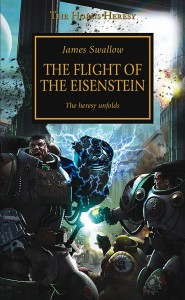 Flight of the Eisenstein by Swallow is the fourth book in the Horus Heresy series. It focuses on Captain Nathaniel Garro of the Death Guard at the moment the Heresy begins in earnest.
Flight of the Eisenstein by Swallow is the fourth book in the Horus Heresy series. It focuses on Captain Nathaniel Garro of the Death Guard at the moment the Heresy begins in earnest.
Synopsis
The story opens with the Death Guard assaulting and obliterating some random alien colony ships, identified as belonging to the Jorgall. For a refreshing change of pace these aliens are fairly different, with insectoid physique and many mechanical augmentations. Interestingly, in many respects the aliens and their tactics resemble Vespid Stingwings of the Tau Empire, between their vaguely buglike structure and jump pack oriented tactics. Besides being an interesting battle sequence, during the battle Garro is given a prophecy by the very alien that seems to be the main concern of a group of Sisters of Battle sent to join the assault, providing some structure and foreshadowing to the remainder of the story.
Afterward, the story moves to Isstvan III where a planetary rebellion is to be crushed by a large contingent of Space Marines. This, of course, is where Horus launches the Heresy overtly, massacring the Marines on the surface. Flight of the Eisenstein covers this pivotal moment from orbit, with Garro and his loyal men barely escaping a group of traitor Marines sent to assassinate them. They then daringly break through the traitor fleet and escape into the Warp.
In the Warp the ship is plagued by its damage, exposing it to the full horrors of the Warp. Walls bleed and distort, strange shadow creatures emerge, and the dead traitor Marines are resurrected as the first Chaos Plague Marines. Eventually the ship is forced to drop out of the Warp, stranded and vulnerable.
Lost, near death, unable to get home, Garro and crew sends a clever but risky signal, leading Rogal Dorn and the Imperial Fists to their location. Though skeptical, Dorn is eventually convinced of Garro’s claims and takes his men home to Terra, where they alert the Empire to the uprising. The fate of Garro and his remaining men is left somewhat open, but it is strongly implied that they are being inducted to become some of the early forces of the newly forming Inquisition.
Thoughts
This is an excellent book, through and through. Having not read any of the previous Horus Heresy books, I was worried that I would be lost with only my general knowledge of the revolt. Fortunately, Flight pretty much stands on its own. General background is good to have, but you don’t need details from the previous books.
This is one of the best 40k books I have read. It really focuses a lot on character development and the universe, punctuated by solid action sequences. Garro is a fairly stereotypical but good, literary Marine—noble, introspective, badass. He’s interesting and portrayed well, particularly his doubts and religious growth. These are really the focus of the novel, with the accelerating development of the cult of the Emperor occupying much of the story. Garro’s anxiety about his role in the universe, his doubts about himself, and his uneasy, hesitant acceptance of the Emperor’s apparent godhood are excellently conveyed and a great read. He is probably the most two dimensional Space Marine I have encountered in 40k fiction, a good thing.
Many of the interactions and other characters are also great, providing a good look at different aspects of the 40k universe and actually including a lot of humanity and emotion. Notably, several Primarchs make an appearance, most notably Rogal Dorn of the Imperial Fists and Mortarion of the Death Guard. Primarchs are frequently not handled well in fiction and background story, but here they convey just the right amount of power and menace. The slowly growing church is also a good peak into the early age of the new era.
On top of all these, the portrayal of the Death Guard on ship in the early parts of the book are fascinating. The usual Marine cliches are downplayed, in favor of intrigue and undercurrents, and a few fascinating rituals. Most notable are Mortarion’s ritual cups of poison, and the simple dressing and undressing of Garro in his armor. The relationships and incidents between Garro, his vassal, and the to-be traitors and loyalists are great, really carried by the tension between Terrans and other worlders, humans and Marines, and the growing divides among the ranks.
Notably, this is the most human portrayal of the Space Marines I have seen. I am not sure if that is because of the specific chapters and characters involved—which makes sense, given many of their members are on the steps of revolt—or that things changed greatly after the Heresy, became more buttoned down. It could also be simply that I just haven’t read enough books about the Marines; most of the 40k novels I’ve read are about the Imperial Guard.
Conclusion
All in all, Flight of the Eisenstein is a great read. I’m not sure how well it could stand without some knowledge of 40k—it’d probably be a little tough to follow and less dramatic—but within that context it’s excellent, and pretty solid outside it as well. Definitely recommended.